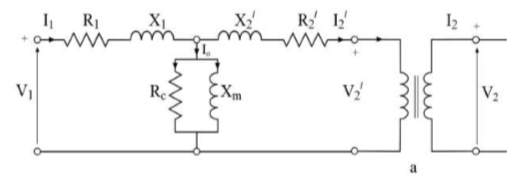Projects:2017s2-291 Measurement of Transformer Parameters
Introduction
A transformer is an electrical device based on Faradays’ law of electromagnetic induction to change alternating voltage, such as increasing or reducing voltage. We are interested in transformer in this project because it is widely be used in power industrial and essential for power transmission over long distance in power grid. Knowing parameters inside transformer will help us understanding the structure of transformer more clearly, and the method used to predict parameters inside transformer is useful for further study measurement which non-linear input and output. This project also improve our ability of dealing with model, how to fit expected model outcomes with reality outcomes and how to analysis and minimize errors between them.
The aim of this project is mapping the transformer device in figure1.2 with the model of equivalence circuit to get 7 parameters value inside transformer model as “accurate” as possible. This project is trying to using figure2 to match with figure 1. In another word, comparing our reality measurement of transformer with the theoretical model and analysis error between them. To summarize the aim of this project: • Analysis the model in figure 1.1, doing the rough test to get a rough 6 parameters. • Substitute these rough parameters into transformer model for open circuit, short circuit and cross circuit of transformer to get these input impedance which record as Zin_model • Measuring the open, short and cross circuit use transformer in figure 1.2 to get input impedance of measure Zin which record as Zin_measure. • Error analysis between Zin_model and Zin_measure, then optimize error and get final 7 parameters result.
Method
In order to get value of R and X, we measure input voltage and current from port A and port B as one terminal which shows in figure 3.1. From ohms law, the input impedance isZin =Vin/Iin. Splitting the real part and imaginary part of Zin to get R and X value respectively. R=real(Zin), X=imaginary(Zin). The one-port model which also known as choke is consist of a resistor and inductor. Two-port model is more complicate than one port model, but the method we used to get parameters is similar as one-port model. Doing open circuit and short circuit for primary side (240V) of transformer and secondary side (24V) and two cross connection tests. Each case of these tests can be regard as one-port test and collect Vin and Iin for each test to calculate Zin based on ohms law. For sub-section Zin model, as we have 6 Zin for open circuit connection, short circuit connection and cross connection, we derive formula for these six Zin based on R1, X1, R2, X2, Rc and Xm then substitute rough parameters we get from section 4 into our derived formula. For measured Zin, the setting up of equipment which including power analyser, oscilloscope for measurement and using varic for power supply. In order to keep current consistency, the Zin for cross connection should be discharged, thus we have 4 Zin to collect. We regarding 4 Zin which has same current as a group, we measure 11 times to get 11 groups of Zin. Actually we have done a lot measurements for these 6 Zin, but only these 11 groups of Zin has the consistency current and useful, I will demonstrate specifically in this sub-section of measured Zin. The sub-section Matlab method is mainly about the method and approach for data analysis.
In the second test, the secondary terminals were connected directly (Figure 23), with input voltage obtained from the same variac. As for the voltage range, the criterion was to ensure that current through both windings would not exceed the maximum current the circuitry can withstand. From the nameplate, the maximum current the secondary winding can tolerate is 0.5A. Based on the ratio of the two windings, which is 9.6 from the transformer model’s nameplate, the maximum current for the primary windings is approximately 52mA. Hence, the input voltage needs to be raised from 0 to a value where the current cannot exceed the maximum current value.
I_p=0.5/9.6≈0.052A
Conclusion and further work
Overall, the project has been successful. All project deliverables were met. The team was able to fulfil the aims and objectives set out at the beginning of the project. The value of parameters inside choke and two-port transformer are estimated, and the RMS relative error for two port parameters of 11 group data are around 3% and no more than 4.4 % which are small and we use fmincon() to optimise parameters value. Instead of the achievement of the aim of this project, there are some finding which related to this project. The impedance of choke is varying with the input condition (input current and voltage), the equilvance circuit (model) of choke is not only a resistor in series with inductor. As giving the choke 1.5A which is the largest current for limitation of choke, it does not saturated as B-H curve still linear. The two-port transformer of input impedance for open, short and cross circuits are also vary with input current, thus we collect 11 groups of data with current consistency. The current consistency 11 group of parameters indicates majority of parameters (R1, R2, X2, a) are nearly constant and stable, X1 decrease until a value and constant, Xm is keep decreasing with increasing current. Therefore, not all parameters are constant with input condition. And there is no exact accurate value for all these 7 parameters, each of parameters has more or less influence with input condition. Further work: It is suggest for further students: • Estimate and use more accurate model for choke to get parameters. • Giving more current to choke to see whether it can saturated, • Keep constant condition when estimating 7 parameters as input impedance for open, short are varying with input current. • Varying frequency of signal instead of using 50 Hz.
